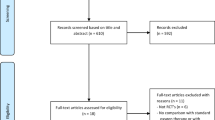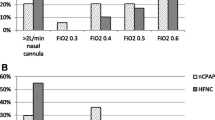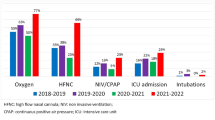Abstract
High-flow nasal cannula (HFNC) is frequently used in infants with acute viral bronchiolitis outside pediatric intensive care units (PICU). A structured questionnaire was sent out to pediatricians of all public French hospitals with pediatric emergency and/or general pediatric departments on their use of HFNC outside PICU (department using HFNC, number of available devices, monitoring, criteria for initiating or stopping HFNC, and personal comments on HFNC). Of the 166 eligible hospitals, 135 answered (96 general and 39 university hospitals; 81.3%), for a total of 217 answering pediatricians. Seventy-two hospitals (53.3%) used HFNC in acute bronchiolitis outside PICU, particularly, general hospitals (59.4% vs 38.5%), and mostly in pediatric general departments (75%). Continuous patient monitoring with a cardiorespiratory monitor was usual (n = 58, 80%). Nursing staff was responsible for 2.7 children on HFNC and checked vital signs 8.6 times per day. Criteria for HFNC initiation and withdrawal were not standardized. Pediatricians had a positive opinion of HFNC and were willing to extend its use to other diseases.
Conclusion: Use of HFNC outside PICU in infants with acute bronchiolitis is now usual, but urgently requires guidelines.
What is Known: • Acute viral bronchiolitis treatment is only supportive • High-flow nasal cannula (HFNC) is a respiratory support accumulating convincing clinical evidence in bronchiolitis • This latter treatment is usually proposed in pediatric intensive care unit (PICU) What is New: • HFNC are increasingly used outside PICU in bronchiolitis, particularly, in general hospitals and in pediatric general departments • Pediatricians are enthusiastic about this device, but validated criteria for initiation and withdrawal are lacking • Guidelines for the use of HFNC outside PICU are urgently required |

Similar content being viewed by others

Abbreviations
- GHC:
-
General hospital center
- UHC:
-
University hospital center
- HFNC:
-
High-flow nasal cannula
- PED:
-
Pediatric emergency department
- PGD:
-
Pediatric general department
- PICU:
-
Pediatric intensive care unit
References
Abboud PA, Roth PJ, Skiles CL, Stolfi A, Rowin ME (2012) Predictors of failure in infants with viral bronchiolitis treated with high-flow, high-humidity nasal cannula therapy. Pediatr Crit Care Med 13:e343–e349
Bourdillon F (2018) Bilan de la surveillance de la bronchiolite 2017–2018, Bulletin épidémiologique INVS, http://invs.santepubliquefrance.fr/Dossiers-thematiques/Maladies-infectieuses/Infections-respiratoires/Bronchiolite/Situation-epidemiologique-de-la-bronchiolite-en-France-metropolitaine/Archives/Bulletin-epidemiologique-bronchiolite.-Bilan-de-la-surveillance-2017-2018. Accessed 11 March 2019
Bressan S, Balzani M, Krauss B, Pettenazzo A, Zanconato S, Baraldin E (2013) High-flow nasal cannula oxygen for bronchiolitis in a pediatric ward: a pilot study. Eur J Pediatr 172:1649–1656
Dysart K, Miller TL, Wolfson MR, Shaffer TH (2009) Research in high flow therapy: mechanisms of action. Respir Med 103:1400–1405
Eaton Turner E, Jenks M (2018) Cost-effectiveness analysis of the use of high-flow oxygen through nasal cannula in intensive care units in NHS England. Expert Rev Pharmacoecon Outcomes Res 18:331–337
Ergui AB, Caliskan E, Sansa H, Goksek I, Koya A, Zararsiz GE, Torun YA (2018) Using a high-flow nasal cannula provides superior results to OxyMask delivery in moderate to severe bronchiolitis: a randomized controlled study. Eur J Pediatr 177:1299–1307
Franklin D, Babl FE, Schlapbach LJ, Oakley E, Craig S, Neutze J, Furyk J, Fraser JF, Jones M, Whitty JA et al (2018) A randomized trial of high-flow oxygen therapy in infants with bronchiolitis. N Engl J Med 378:1121–1131
Goh CT, Kirby LJ, Schell DN, Egan JR (2017) Humidified high-flow nasal cannula oxygen in bronchiolitis reduces need for invasive ventilation but not intensive care admission. J Paediatr Child Health 53:897–902
González Martínez F, González Sánchez MI, Rodríguez Fernández R (2013) Clinical impact of introducing ventilation with high flow oxygen in the treatment of bronchiolitis in a paediatric ward. An Pediatr 78:210–215
Griffiths B, Riphagen S, Lillie J (2018) Management of severe bronchiolitis: impact of NICE guidelines. Arch Dis Child 0:1–3
Hall CB, Weinberg GA, Iwane MK, Blumkin AK, Edwards KM, Staat MA, Auinger P, Griffin MR, Poehling KA, Erdman D et al (2009) The burden of respiratory syncytial virus infection in young children. N Engl J Med 360:588–598
Heikkilä P, Forma L, Korppi M (2016) High-flow oxygen therapy is more cost-effective for bronchiolitis than standard treatment—a decision-tree analysis. Pediatr Pulmonol 51:1393–1402
Heikkilä P, Sokuri P, Mecklin M, Nuolivirta K, Tapiainen T, Peltoniemi O, Renko M, Korppi M (2018) Using high-flow nasal cannulas for infants with bronchiolitis admitted to paediatric wards is safe and feasible. Acta Paediatr 107:1971–1976
Kelly GS, Simon HK, Sturm JJ (2013) High-flow nasal cannula use in children with respiratory distress in the emergency department: predicting the need for subsequent intubation. Pediatr Emerg Care 29:888–892
Kepreotes E, Whitehead B, Attia J, Oldmeadow C, Collison A, Searles A, Goddard B, Hilton J, Lee M, Mattes J (2017) High-flow warm humidified oxygen versus standard low-flow nasal cannula oxygen for moderate bronchiolitis (HFWHO RCT): an open, phase 4, randomised controlled trial. Lancet 389:930–939
Mayfield S, Bogossian F, O’Malley L, Schibler A (2014) High-flow nasal cannula oxygen therapy for infants with bronchiolitis: pilot study. J Paediatr Child Health 50:373–378
McKiernan C, Chua LC, Visintainer PF, Allen H (2010) High flow nasal cannulae therapy in infants with bronchiolitis. J Pediatr 156:634–638
Mikalsen IB, Davis P, Øymar K (2016) High flow nasal cannula in children: a literature review. Scand J Trauma Resusc Emerg Med 24:93
Milani GP, Plebani AM, Arturi E, Brusa D, Esposito S, Dell’Era L, Laicini EA, Consonni D, Agostoni C, Fossali EF (2016) Using a high-flow nasal cannula provided superior results to low-flow oxygen delivery in moderate to severe bronchiolitis. Acta Paediatr 105:e368–e372
Milési C, Baleine J, Matecki S, Durand S, Combes C, Novais AR, Cambonie G (2013) Is treatment with a high flow nasal cannula effective in acute viral bronchiolitis? A physiologic study. Intensive Care Med 39:1088–1094
Milési C, Pierre AF, Deho A, Pouyau R, Liet JM, Guillot C, Guilbert AS, Rambaud J, Millet A, Afanetti M et al (2018) A multicenter randomized controlled trial of a 3-L/kg/min versus 2-L/kg/min high-flow nasal cannula flow rate in young infants with severe viral bronchiolitis (TRAMONTANE 2). Intensive Care Med 44:1870–1187
Oakley E, Borland M, Neutze J, Acworth J, Krieser D, Dalziel S, Davidson A, Donath S, Jachno K, South M, Theophilos T et al (2013) Nasogastric hydration versus intravenous hydration for infants with bronchiolitis: a randomised trial. Lancet Respir Med 1:113–120
Slain KN, Shein SL, Rotta AT (2017) The use of high-flow nasal cannula in the pediatric emergency department. J Pediatr (Rio J) 93(Suppl 1):36–45
Sokuri P, Heikkilä P, Korppi M (2017) National high-flow nasal cannula and bronchiolitis survey highlights need for further research and evidence-based guidelines. Acta Paediatr 106:1998–2003
Van Miert C, Fernandes RM, Eccleson H, Bedson E, Lane S, Peak M, Thorburn K, Compton V, Woolfall K, Lacy D et al (2018) Non-invasive ventilation for the management of children with bronchiolitis (NOVEMBR): a feasibility study and core outcome set development protocol. Trials 14(19):627
Wing R, James C, Maranda LS, Armsby CC (2012) Use of high-flow nasal cannula support in the emergency department reduces the need for intubation in pediatric acute respiratory insufficiency. Pediatr Emerg Care 28:1117–1123
Xing Y, Proesmans M (2019) New therapies for acute RSV infections: where are we? Eur J Pediatr 178:131–138
Zorc JJ, Hall CB (2010) Bronchiolitis: recent evidence on diagnosis and management. Pediatrics 125:342–349
Author information
Authors and Affiliations
Contributions
MP, CF, ES, and JCD conceived the study and designed the trial. JCD and EB supervised data collection. ST provided statistical advice on study design and analyzed the data. MP and CF drafted the manuscript, and all authors contributed substantially to its revision. JCD takes responsibility for the paper as a whole.
Corresponding author
Ethics declarations
Conflict of interest
The authors declare that they have no conflict of interest.
Ethical approval
For this type of study, formal consent and ethics committee are not required.
Additional information
Communicated by Peter de Winter
Publisher’s note
Springer Nature remains neutral with regard to jurisdictional claims in published maps and institutional affiliations.
Mélanie Panciatici and Candice Fabre are declared as co-first authors
Rights and permissions
About this article
Cite this article
Panciatici, M., Fabre, C., Tardieu, S. et al. Use of high-flow nasal cannula in infants with viral bronchiolitis outside pediatric intensive care units. Eur J Pediatr 178, 1479–1484 (2019). https://doi.org/10.1007/s00431-019-03434-4
Received:
Revised:
Accepted:
Published:
Issue Date:
DOI: https://doi.org/10.1007/s00431-019-03434-4



